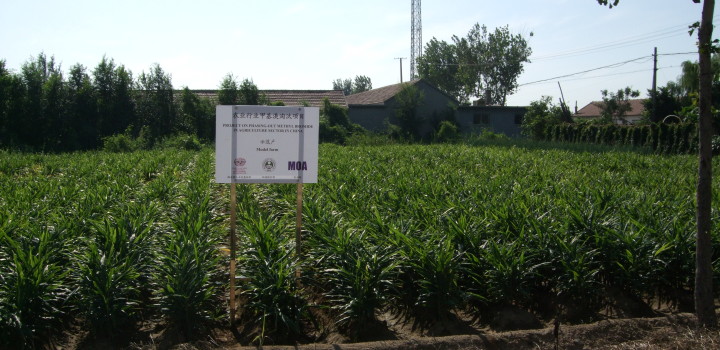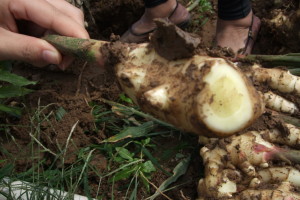CONSULTING SERVICE ON ROOT-KNOT NEMATODES AND OTHER PATHOGEN ISOLATION, IDENTIFICATION, ASSESSMENT AND CONTROL ON GINGER CROP IN CHINA
Contractor
Center for Agricultural Experimentation and Assistance (CeRSAA) – Albenga (SV), Italy
Funding body
United Nations Industrial Development Organization (UNIDO) – Vienna, Austria
Objectives
Since China ratified the Copenhagen amendment to the Montreal Protocol as a developing country, committed to phase-out the methyl bromide by 2015, used as active ingredient on strawberry, cucumber, tomato, eggplant and ginger crops.
Registered products different from MB (such as chloropicrin) are used nowadays, but no one is really as effective as it is. MB has been listed in 1992, in the Montreal Protocol, as an Ozone Depleting Substance that must be phased out, also because of its high toxicity and the quick evaporation. This substance is an odorless and colorless gas at normal temperature and pressure, used as a soil fumigant to control pests, insects, nematodes, weeds, pathogens and rodents across a wide range of agricultural sectors.
China started the phasing out process in agricultural sector in 2008, the active ingredient, used on strawberry, cucumber, tomato, eggplant and ginger crops, started to be abandoned in three Chinese Provinces (Hebei, Liaoning and Shandong).
Ginger main producing areas are Weifang, Laiwu and Yantai in Shandong Province and the three main soil-borne diseases related to ginger crops are root-knot nematodes, the bacterial wilt caused by Ralstonia solanacearum and the pathogens like Pythium spp..
The overall objective of the project is to find sustainable alternatives against pests and pathogens causing diseases to ginger crops and roots.
Valid sustainable alternatives can be both related to chemical substances and to non-chemical options such as crop rotation, using of plant extracts, organic amendments, soil solarization, biological control agents, the adoption of specific cultural practices and plant breeding.
More specifically, the project will pass through:
– the evaluation of disease spread
– the collection of soil and plant samples both in Model and non-model farms in Laiwu, Anqiu, Laizhou and Longkou in Shandong Province.
The definition of a model farm is as follows: the farms that are located in areas with intensive plantation of ginger; the households have some knowledge of soil fumigation and capabilities to acquire new knowledge; the soil has typical diseases or pests; the households are willing to demonstrate the model to other households (www.unido.org).
– the study of plant diseases and symptoms
– the examination of the correct implementation of diagnosis protocol
– the investigation of the effect of the suggested control alternatives on ginger crops
– laboratory inspections so as to verify the correct implementation of diagnosis protocols to apply corrective measures, if necessary
– technical trainings to Chinese experts to implement the knowledge in the field of plant pathology, nematology and molecular biology.
As mentioned, field activities of the project will be developed in Shandong Province, whereas the isolation and the identification of plant pathogens and pests will be carried out in the Laboratory of Beijing of the Institute of Plant Protection Chinese Academy of Agricultural Sciences (IPP-CAAS).
Materials and methods
Main steps of the project are:
- Preliminary home-base activities based on: the identification of Chinese experts in plant pathology, nematology and molecular biology; a set-up of a questionnaire to collect information about growing system, main phytopathological problems, already implemented control techniques, potential diagnosis and analysis techniques, suitable means for the dissemination of the outcomes of projects activities.
- On-site and home-base surveys based on: the collection of on-site information about disease symptoms; the development of a methodology for the isolation and the identification of pathogenic bacteria, fungi and nematodes; technical training on root-knot nematodes and other pathogens identification and pathogenicity assessment;
- Recommendation on MB alternative technologies to be applied on ginger crop;
- On-site surveys and inspections in order to: verify disease spread, the correct implementation of diagnosis protocols and eventually plan further analysis or corrective measures, if required;
- Home-base activities for the development of analysis techniques for the isolation and the identification of pathogenic bacteria, fungi and root-knot nematodes.
Outcomes
- phase-out of methyl bromide, evaluated as an ozone depleting gas also because of its high toxicity and the quick evaporation
- development of practices for a sustainable agriculture
- set up of protocols for the effective application of MB alternatives for ginger production
- set up of protocols for an effective tele-diagnosis (virtual lab) applied to relevant plant pathogens
First surveys
During the first two missions in China, the following issues were taken in consideration and discussed together with Chinese experts and consultants:
- the comparison among Methyl Bromide (efficacy, costs, …), other chemical active ingredients used in China (efficacy, costs, …) and the alternative suggested substances (efficacy, costs, …);
- the suggestion of irrigation methods alternative to flooding, nowadays used in China and the promotion of other methods, as drip or sprinkler irrigation, together with soil mulching;
- the introduction of standards (e.g. EPPO standard) for a better implementation of pest and disease monitoring and analysis and implementation of control measures;
- the risks related to the foliage residues left on the soil and the difficulty to compost them, which can significantly increase the risk of a re-infestation of the soil;
- the analysis of the entire “cycle” of ginger, from transplanting until harvesting, has underlined different critical points (e.g. the necessary dipping combined with other treatments, such as a thermotherapy in order to preserve rizomes used for the subsequent crop cycle, …);
- the possibility to set up monitoring protocols as well as demonstrative field trials on soil disinfestation.


